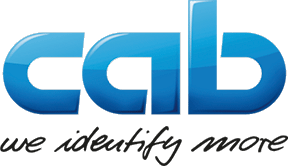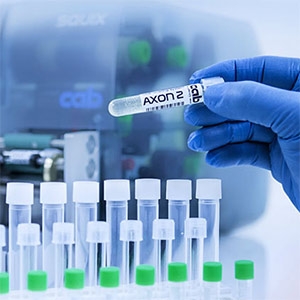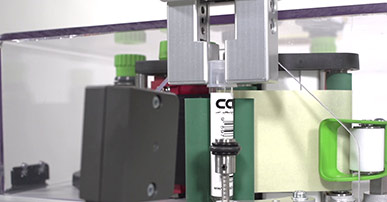Healthcare labeling
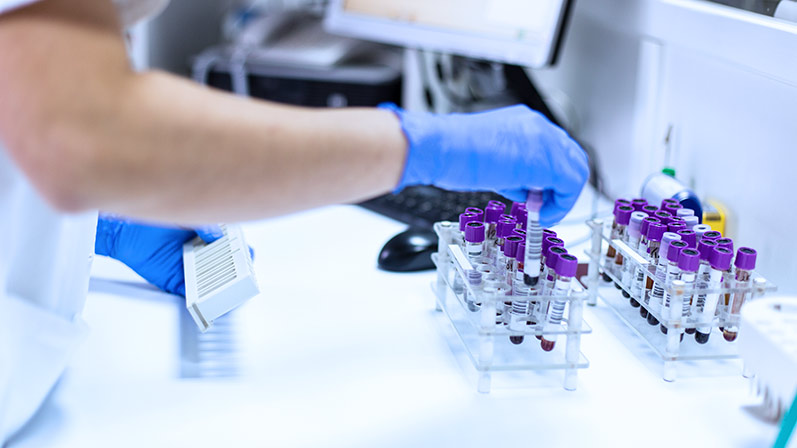
In hospitals and clinics, medical offices, pharmacies and labs many things are relevant to health. Samples in tubes, vials or ampoules, for example, must be assigned reliably, as must patients and medication in the course of treatment. Personal data require confidentiality. Medical instruments must be traceable to its smallest component at any time. To avoid errors, handwriting is out of date. cab provides reliable equipment, intuitive and highly adaptable, if operated stand-alone or in an automation solution. Depending on the use, labels or laser marking are first choice.
Key issues:
- Identification
- Traceability
- Warning / Safety
- Automation
Labels
Select the right method
Thermal transfer printing enables up to 600 dpi, high contrast and sharp-edged images. As a result, even very small prints can be verified perfectly by eye or by scanners. Printed data resist to mechanical influences, water and solvents. Identities, as well as dates of manufacture and expiration, remain legible at any time, specific codes and numbers also during processing and longterm stock. Inquiries and disruptions to patient care are reduced to a minimum, so are delays in the development and manufacture of medication. There is no waiting for colors to dry, as is the case with inkjet printing. Any desired roll stock can be printed non-stop. By selecting consumables in line with thermal printing, clinics and the like commonly increase productivity, as well as reliability in matters of identification.
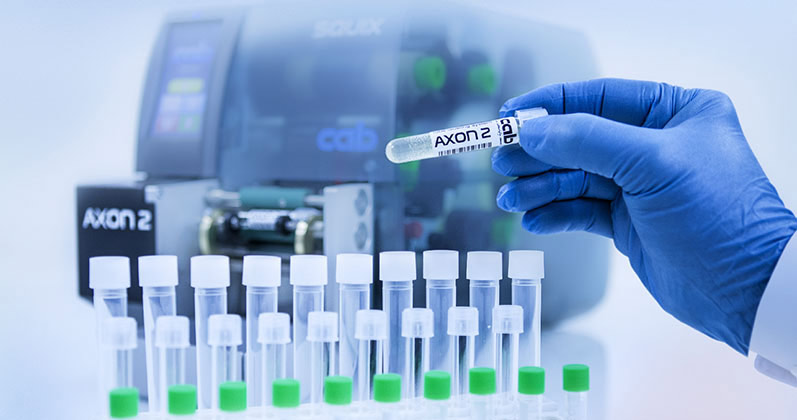
Select the right materials
Sterilizing at vapor pressure, stocking samples at temperatures close to minus 200 °C in liquid nitrogen, or dyeing can damage a label, turn it void or detach it from a vessel. Synthetic labels and ribbons recommended by cab for healthcare use are tested for all common resistances. The surfaces of such labels have been designed for thermal transfer printing, roll diameters and cores adapt to cab printers, so does the winding. cab consultants provide support, from selecting a material to its integration at the point of use. Polyolefin is recommended for cryo use, Polyester for tamper evidence. Black cab R11, R71, R91 ribbons in resin quality are matching.
Select the right printer
Intelligent firmware, lean cab JScript programming language design and a highly performant CPU joining forces on cab label printers results in rapid processing. A proven SQUIX label printer, once a print job has been triggered, has printed the first line on a label in less than a second. The printing of labels can be triggered and controlled entirely by software. Input and output do not require complex wiring. The printer can be operated on the unit or remote using the web interface on a smartphone, tablet or PC. cab label printing systems integrate in automation and robot solutions.
Examples of operation
Samples: Samples analyzed microscopically or stored in a lab are irreplaceable. Their value is accordingly high. Regularly, they are processed in tubes or vials. These can be labeled particularly quick and reliable on printers into which insert vessels manually or automatically, for example by a robot, and provide an applicator. AXON 1 by cab solves such profiles, so does an AXON 2 applicator assembled to a SQUIX 4 MP printer. Printing a label and applying it takes less than two seconds with both models. Once a tube has been labeled, it can be removed one by one or ejected to a tray. cab in addition provides further systems for labeling cylindrical items around their circumference.
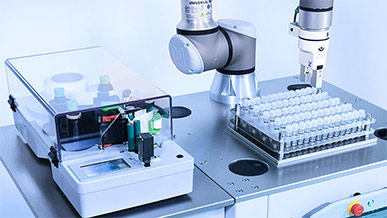
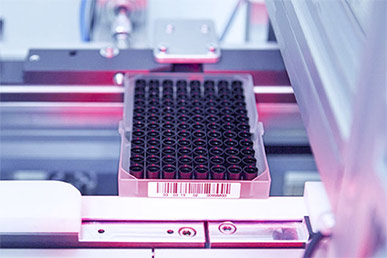
Item carriers: Printers providing an applicator accurately label carrier frames of different sizes and shapes. Labels are transferred by a pad. Stroke lengths are selected according to the height of an item, pads according to its surface structure. For example, labels printed by a cab SQUIX printer can be applied to test tube carriers by a lifting applicator. A rotary and a lifting cylinder can be combined for labeling microtiter plates.
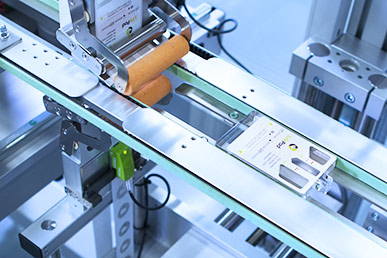 Test cassettes are known to the masses at the latest from the corona pandemic. PCR kits are still used by doctors, in pharmacies and labs. They are packed in fully automated plants and labeled compliant with pharmaceutical regulations. IXOR labeling heads by cab apply on these in large quantities self-adhesive labels quick and precisely, in continuous or clocked operation. Depending on the equipment in use, materials and size of a label, a maximum of 2,400 labels per minute can be applied synchronous to the speed of a product. By integrating a PX Q print module ahead of or subsequent to label application, flexible data, such as shelf lives, can be added on a label.
Test cassettes are known to the masses at the latest from the corona pandemic. PCR kits are still used by doctors, in pharmacies and labs. They are packed in fully automated plants and labeled compliant with pharmaceutical regulations. IXOR labeling heads by cab apply on these in large quantities self-adhesive labels quick and precisely, in continuous or clocked operation. Depending on the equipment in use, materials and size of a label, a maximum of 2,400 labels per minute can be applied synchronous to the speed of a product. By integrating a PX Q print module ahead of or subsequent to label application, flexible data, such as shelf lives, can be added on a label.
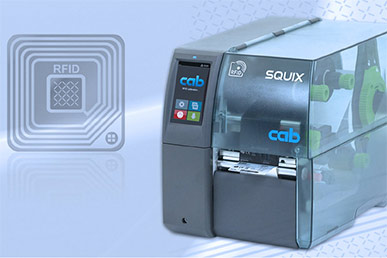 Logistics: RFID technology has proven worthy when tracking and tracing medical goods. On this occasion, radio signals transport information along an electromagnetic field. RFID labeling differs from standard label printing. In addition to a print job, label printers receive information to store on the RFID microchip of a label. RFID labels are self-adhesive labels providing a RFID chip and a RFID antenna (henceforth called ‘RFID tag’). Requests by a reader system to a tag in the magnetic field are captured by the tag antenna, forwarded to the chip and finally answered, for example a serial number. Response received from the reader system can be recorded and processed by software. The principle is similar to scanning a 2D code or a barcode, but provides other benefits. cab as an option provides SQUIX series printers with an UHF RFID reader/writer module and a RFID antenna.
Logistics: RFID technology has proven worthy when tracking and tracing medical goods. On this occasion, radio signals transport information along an electromagnetic field. RFID labeling differs from standard label printing. In addition to a print job, label printers receive information to store on the RFID microchip of a label. RFID labels are self-adhesive labels providing a RFID chip and a RFID antenna (henceforth called ‘RFID tag’). Requests by a reader system to a tag in the magnetic field are captured by the tag antenna, forwarded to the chip and finally answered, for example a serial number. Response received from the reader system can be recorded and processed by software. The principle is similar to scanning a 2D code or a barcode, but provides other benefits. cab as an option provides SQUIX series printers with an UHF RFID reader/writer module and a RFID antenna.
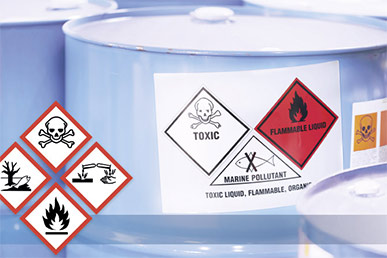
GHS: Anyone who puts potentially hazardous substances into circulation, such as chemicals, must label them clearly. The Globally Harmonized System provides uniform guidelines. Warning symbols are defined as black pictograms on a white background, framed by a red rhombus. cab printers of the XC Q series enable printing with two colors on a label in one operation, providing an additional print head for the spot color. In the matter of labeling hazardous goods, as a result, operators must no longer provide pre-printed label stock. When it comes to labels be applied automatically to containers subsequent to two-color printing, a Hermes C print and apply system is first choice.
Economical automation
State of the art healthcare information management intends for automated processes. Lab work includes, for example, receipts of orders, formation of samples, centrifugation and analysis according to specific parameters. Results are validated, samples and data documented and archived, reports transmitted. More and more automated LIMS are in use, assuring quality according to ISO standards, managing all data transfers inhouse, to authorities or clients, compliant with Good Laboratory Practice (GLP). Employees, systems and components in automated Laboratory Information Management Systems continuously process information, feed in or remove data. Labs benefit from accelerated workflows, high conformity, productivity and quality, customers from reduced costs. Raw data and related metadata are hosted in a cloud, encrypted, to be exchanged easily and in a secure way between different systems. cab units provide as a standard all the physical interfaces necessary for integration to a network. Protocols such as OPC-UA standardize interactions and communication independent from platforms. Control or measuring values can be exchanged in a secure way. The WebDAV transfer protocol enables virtual memories integrate to cab units via a network. The web memory can be accessed as a drive anywhere.
Laser marking

Select the right laser
A laser provides permanent, explicit markings on medical instruments without touching. The items remain mechanically unaffected. It is hard to say in general which type of laser system is the right one. Each operation is individual. Is it about a single workstation or marking within a plant? Items, their materials and surfaces are also decisive. Metals or synthetics are widely used in healthcare.
Benefits of a fiber laser
Taylored to an operation, fiber lasers achieve very high efficiency and require significantly less energy than CO2 lasers, for example. There is higher investment compared to a printing or label application system, but is amortized by freedom from maintenance. For example, there is no need to change consumables. cab XENO systems consist of a control unit and a scan head. The latter connects to a beam source integral to the control unit. Highest beam powers are achieved by fiber focusing, as performed by a lens on the scan head. This as well allows for covering a specific marking field. The smaller the marking field, the higher the resolution of a marking, a general industrial rule says.
Further benefits of this technique:
- Focus on smallest spots. Thanks to high beam quality, even radii and uneven component surfaces can be marked.
- Processing at high speed (up to 5,000 mm/s with XENO 4 scan heads), as strongly focused light does not have to overcome mechanical resistance
- Pin sharp marking, i.e. resolutions up to 1.000 dpi
- Proof to smudge, acids or alkalis, solvents, UV radiation, heat and wear
Examples of operation
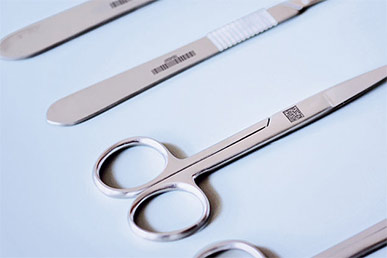 Laboratory instruments, microscope slides
Laboratory instruments, microscope slides
Tweezers, pliers or scissors are indispensable auxiliaries, used again and again in healthcare. Unique Device Identification (UDI) at this sets directives on encoding and marking, such as tamper-resistance, quality and process assurance. The same applies to sterile disposable items such as syringes and canulas, implants and prostheses. Thanks to permanent laser marking, a surgical clamp, for example, may be tracked by a number to its origin. Data stored for this purpose enables other specimens of a lot be checked. Possible shortcomings, such as a complaints during inspection, are eliminated. Think also of thin microscope slides used for recording and analyzing micro specimens. These also may be marked with a laser on surfaces painted single-colored. The compact XENO 1 desktop system has proven particularly successful with lab processes. A protective chassis according to laser protection class 1A integrates the laser source and the control unit. The system is delivered ready for operation.
Highly integratable
In addition to UDI, healthcare is also confronted with general requirements of the EU, prevention of harmful substances, and the packing regulation. Think of items and marking change continuously in a business. cab lasers are prepared for this. They are developed with a Performance Level d and provide all necessary safety and communication interfaces. Whether it is XENO 4 for marking high quantities in fully automatic plants, a LM+ system solution for marking label films directly from a roll or XENO 3 for marking type plates – there is a solution for any requirement. In terms of individual components or small batches, the XENO 4 can be operated in a LSG+100E safety housing as a manual workstation. A XENO 1 desktop unit can be setup "out of the box" and operated effortlessly. All cab laser systems are controlled via matured marking software.
BY THE WAY
cab delivers equipment to fit, accelerates process times, simplifies operation, integrates equipment exactly in information systems and is on the spot to understand requirements in detail. Longevity often plays a key role with equipment in healthcare.
March 2023
